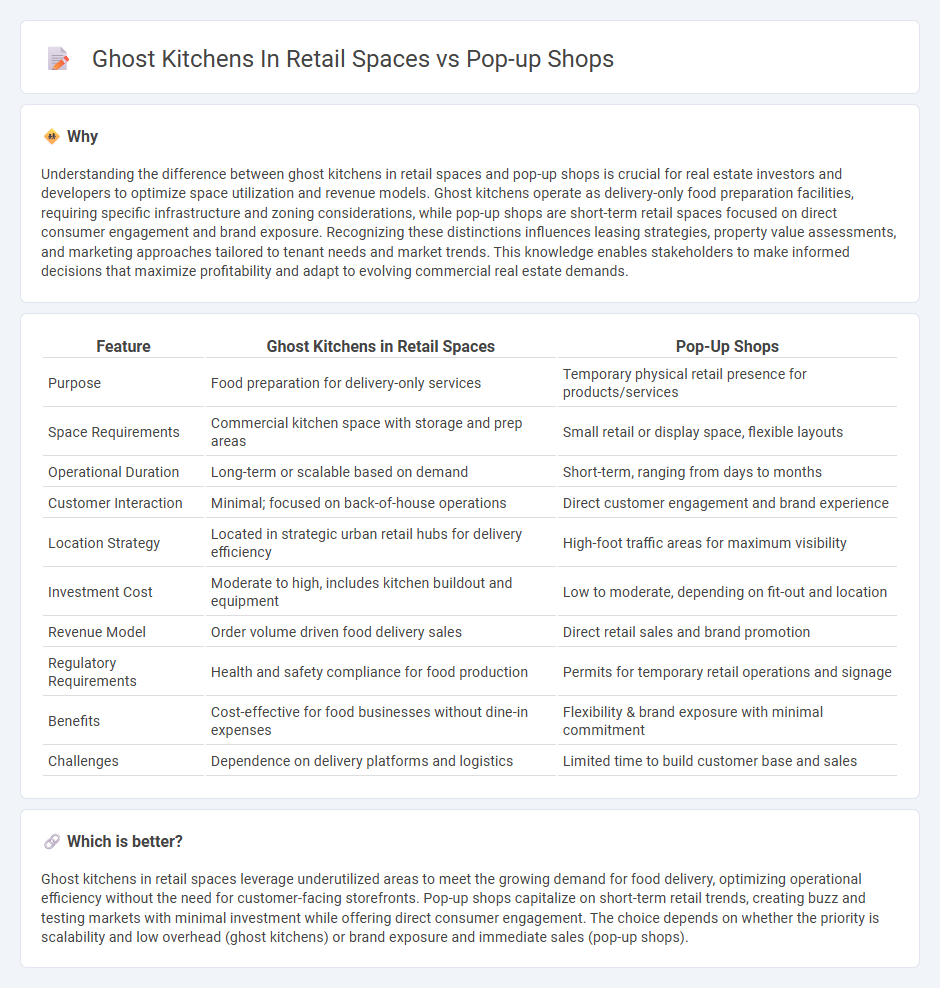
Ghost kitchens in retail spaces optimize real estate by transforming underutilized areas into efficient food preparation hubs, reducing overhead costs and expanding delivery reach. Pop-up shops leverage short-term leases to create dynamic retail experiences, driving brand visibility and customer engagement in high-traffic locations. Explore how these innovative models are reshaping commercial real estate opportunities.
Why it is important
Understanding the difference between ghost kitchens in retail spaces and pop-up shops is crucial for real estate investors and developers to optimize space utilization and revenue models. Ghost kitchens operate as delivery-only food preparation facilities, requiring specific infrastructure and zoning considerations, while pop-up shops are short-term retail spaces focused on direct consumer engagement and brand exposure. Recognizing these distinctions influences leasing strategies, property value assessments, and marketing approaches tailored to tenant needs and market trends. This knowledge enables stakeholders to make informed decisions that maximize profitability and adapt to evolving commercial real estate demands.
Comparison Table
| Feature | Ghost Kitchens in Retail Spaces | Pop-Up Shops |
|---|---|---|
| Purpose | Food preparation for delivery-only services | Temporary physical retail presence for products/services |
| Space Requirements | Commercial kitchen space with storage and prep areas | Small retail or display space, flexible layouts |
| Operational Duration | Long-term or scalable based on demand | Short-term, ranging from days to months |
| Customer Interaction | Minimal; focused on back-of-house operations | Direct customer engagement and brand experience |
| Location Strategy | Located in strategic urban retail hubs for delivery efficiency | High-foot traffic areas for maximum visibility |
| Investment Cost | Moderate to high, includes kitchen buildout and equipment | Low to moderate, depending on fit-out and location |
| Revenue Model | Order volume driven food delivery sales | Direct retail sales and brand promotion |
| Regulatory Requirements | Health and safety compliance for food production | Permits for temporary retail operations and signage |
| Benefits | Cost-effective for food businesses without dine-in expenses | Flexibility & brand exposure with minimal commitment |
| Challenges | Dependence on delivery platforms and logistics | Limited time to build customer base and sales |
Which is better?
Ghost kitchens in retail spaces leverage underutilized areas to meet the growing demand for food delivery, optimizing operational efficiency without the need for customer-facing storefronts. Pop-up shops capitalize on short-term retail trends, creating buzz and testing markets with minimal investment while offering direct consumer engagement. The choice depends on whether the priority is scalability and low overhead (ghost kitchens) or brand exposure and immediate sales (pop-up shops).
Connection
Ghost kitchens leverage retail spaces and pop-up shops by transforming underutilized real estate into flexible food preparation zones, maximizing spatial efficiency. These kitchens capitalize on the surge in food delivery demand without the need for traditional storefronts, allowing landlords to generate revenue from temporary tenants. This symbiotic relationship enhances the value of retail properties amid evolving consumer preferences and shifts in urban commercial real estate usage.
Key Terms
Temporary Leasing
Pop-up shops and ghost kitchens represent innovative approaches to temporary leasing in retail spaces, with pop-up shops focusing on short-term physical retail experiences and ghost kitchens emphasizing food delivery operations without dine-in facilities. Both models leverage temporary leasing to reduce overhead costs and test market demand quickly, attracting diverse consumer segments with flexible, location-based strategies. Explore the distinct advantages and strategic applications of pop-up shops and ghost kitchens in transforming modern retail leasing.
Foot Traffic
Pop-up shops leverage temporary retail spaces to generate high foot traffic through unique, engaging in-person experiences, attracting customers with limited-time offers and exclusive products. Ghost kitchens operate behind the scenes without physical storefronts, relying on delivery apps and online orders, which reduces walk-in customer flow but maximizes operational efficiency. Explore how integrating both concepts can optimize retail space utilization and boost overall customer engagement.
Adaptable Infrastructure
Pop-up shops utilize adaptable infrastructure by transforming retail spaces quickly to showcase seasonal products or limited-time offers, maximizing customer engagement without long-term commitments. Ghost kitchens optimize infrastructure by repurposing retail areas into cost-effective, delivery-only food production zones, reducing overhead and increasing operational flexibility. Explore more on how adaptable infrastructure drives innovation in retail and food service sectors.
Source and External Links
What is a Pop-up Shop? Benefits, Types, and How to Start - This guide explains the concept of pop-up shops, their benefits, and how to launch them for both physical and online retail experiences.
Pop-up Retail - The Wikipedia article provides a comprehensive overview of pop-up retail, including its concept, benefits, and various applications across different industries.
What is a Pop-up Shop? - This article from Storefront explores the definition, history, and benefits of pop-up shops, highlighting their flexibility and adaptability in retail.
 dowidth.com
dowidth.com